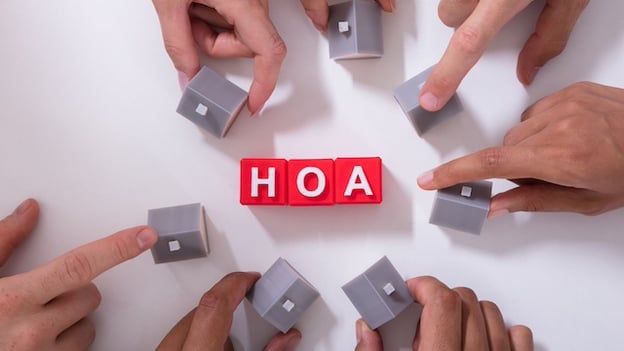HOA board elections may not be the most exciting topic for many, but they hold significant influence over community dynamics and property values. During the election process, homeowners are tasked with voting for important roles in the association, such as president, vice president, treasurer, and secretary.
Whether you're a seasoned board member or a new member of the community looking to join the board, understanding the ins and outs of board elections is crucial for ensuring your voice is heard and your community thrives. Read on as we explore everything you need to know about the HOA board election process.
HOA Board Election Basics
As with any election, it’s essential to be properly informed on how the process works. Let’s get into the basics of HOA board elections!
Who gets elected to board member positions?
The specific qualifications and requirements to become a board member can vary depending on the HOA's governing documents and state laws. However, in general, candidates for board positions must be homeowners within the community and in good standing with the HOA, meaning they are up-to-date on their dues and any other financial obligations. In some instances, renters may also be able to join the board.
Candidates for board positions often present themselves to the community by expressing their interest in serving, outlining their qualifications, and sharing their vision for the community's future. Homeowners then have the opportunity to vote for their preferred candidates during the HOA's election process, which typically occurs annually or as otherwise specified in the governing documents.
How often do elections take place?
The frequency of board elections can vary depending on the association’s governing documents and state laws. In many cases, elections are typically held annually, but some communities may hold them less frequently, such as every two or three years.
It's important for homeowners to familiarize themselves with their association’s bylaws or CC&Rs (covenants, conditions, and restrictions) to understand the specific election procedures and timelines outlined for their community. These documents will specify when elections are held, how candidates are nominated, the voting process, and any other relevant details regarding the governance of the association.
In some instances, special elections may be called to fill board vacancies that arise between regular election cycles. These vacancies could occur due to resignations, removals, or other circumstances. The procedures for filling vacancies are typically outlined in the association’s governing documents as well.
Legal Framework Governing HOA Board Elections
Although the community’s governing documents outline the rules for elections, associations must also follow local laws. Below, we’ll discuss some of the legalities of HOA board elections.
State Laws and Their Impact on HOA Elections
It's essential to recognize that state laws can vary greatly, and their direct impact on community associations can be significant. One of the primary factors influencing the legal framework surrounding HOA elections is the state's perspective on community associations as nonprofit organizations or separate legal entities. This perspective dictates the laws applicable to the electoral process and governs various aspects of association operations.
Compliance with state laws is not merely a recommendation but a necessity for community associations when conducting elections. Failure to adhere to these regulations can have serious legal repercussions for the association and its members. Therefore, understanding and following the specific statutes and regulations set forth by the state is crucial for maintaining the legitimacy and integrity of the election process.
The Role of Association Bylaws
Bylaws serve as the cornerstone for establishing election procedures within community associations, providing a structured framework that governs various aspects of the electoral process. These bylaws typically outline procedures for scheduling elections, determining eligibility criteria for candidates, defining voting rights, and specifying procedures for counting votes.
Establishing Election Procedures
Association bylaws detail the specific protocols and timelines for conducting elections within the community. This includes setting dates for nomination periods, establishing deadlines for candidate submissions, and scheduling the actual voting day. Bylaws also typically delineate eligibility criteria for candidates, such as residency requirements or the absence of any delinquent dues or violations.
In addition, they outline voting rights, specifying who is entitled to vote and whether proxies or absentee ballots are permissible. Procedures for counting votes, resolving disputes, and certifying election results are also typically addressed in the bylaws.
Bylaws vs. State Laws
While association bylaws provide a comprehensive framework for election procedures, they must also align with state laws governing elections. State legislation may impose additional requirements or restrictions that HOAs must adhere to, necessitating amendments to the association's bylaws to ensure compliance. For example, a state may mandate certain procedures for notifying members about elections, specify the format of the ballot, or require a minimum quorum for election results to be valid. In such cases, associations may need to revise their bylaws to incorporate these statutory requirements.
It's crucial for bylaws to be clear, comprehensive, and readily accessible to all members. This ensures that everyone understands their rights and responsibilities regarding the election process and helps prevent misunderstandings or disputes. Bylaws should be regularly reviewed and updated as needed to reflect any changes in state laws or evolving community needs. Transparency and inclusivity in the bylaw amendment process are also essential to maintain trust and confidence among homeowners.
Ensuring Compliance and Fair Play
Ensuring compliance and fair play in HOA elections requires diligent monitoring and enforcement of election processes to align with both state laws and association bylaws. Here's how associations can achieve this:
Monitoring and Enforcement
Communities can establish election committees or enlist the services of third-party administrators to oversee the election process. These entities ensure that all aspects of the election—from candidate nominations to vote counting—are conducted in accordance with state laws and association bylaws. Election committees or administrators can monitor the adherence to timelines, eligibility criteria, voting procedures, and the handling of ballots to maintain fairness and transparency.
Amendments and Updates
Regular review and potential amendment of association bylaws are crucial to adapt to changes in state laws or address issues encountered in previous elections. By staying current with legal requirements and addressing any shortcomings in the election process, associations can ensure that elections remain legitimate and reflective of the democratic principles upon which they are based. This proactive approach also helps to prevent legal challenges or disputes that may arise from non-compliance with state laws or inconsistencies in bylaws.
Consider Online Voting
Transitioning to an online voting system can help reduce or eliminate voter fraud. Electronic voting, however, has its advantages and disadvantages. E-voting increases the likelihood that people will participate in an election. Homeowners can vote remotely using smartphones and computers.
Online voting will allow most boards to reach a voting quorum because more people will participate. The results are tabulated by machine, so it's harder to commit fraud. Additionally, every individual gets a unique registration code to vote.
HOA Board Election Timeline
Now that we’ve gone over some of the HOA board election rules, you may be wondering what the timeline is for the election process. Below, are some of the things you can expect. However, it’s important to remember that the exact timeline will vary by community.
Preparing for Elections
Preparing for HOA elections involves ensuring clarity regarding membership and voting rights, as well as establishing transparent election procedures. Here's a breakdown:
Membership and Voting Rights
Before delving into the specifics of election mechanics, it's essential to understand who is eligible to participate and how they can vote. Membership and voting rights form the foundation of the democratic process in HOA elections.
- Eligibility: Typically, only property owners within the community are eligible to vote in elections. This excludes renters or non-owners unless specified otherwise in the association's bylaws or state laws.
- Proxy Voting: Proxies allow members who cannot attend the election meeting to appoint someone else to vote on their behalf. Conditions for proxy voting, such as the need for written authorization or specific forms, should be clearly outlined in the association's bylaws.
Election Procedures
The election process is a structured sequence of activities, from nominating candidates to casting and counting votes. Establishing clear and fair election procedures is crucial to the integrity of the election.
- Nomination Process: The election process usually begins with the nomination of candidates for positions such as officers and directors. Members may nominate themselves or others, following any guidelines outlined in the bylaws.
- Candidate Eligibility: Ensure that all nominated candidates meet the eligibility criteria specified in the association's bylaws, which may include factors such as membership status, residency, and absence of any conflicts of interest.
- Voting Methods: Associations can employ various voting methods, including in-person, mail-in, or online voting. The chosen method should be accessible and convenient for all eligible members. If multiple voting methods are available, ensure clear instructions and deadlines are provided for each.
- Counting Votes: Establish procedures for collecting and counting votes to ensure accuracy and transparency. This may involve appointing an election committee or utilizing a third-party administrator to oversee the process.
- Electing Officers and Directors: After votes are cast and counted, the candidates with the highest vote totals are elected to their respective positions. Ensure that the bylaws specify the terms of office, any term limits, and procedures for filling vacancies if necessary.
Conducting the Election
Conducting successful HOA elections requires effective communication with the community and careful consideration of voting methods and quorum requirements. Let’s take a look at how to navigate these aspects.
Communicating with the Community
Effective communication is the cornerstone of a successful HOA election, serving to inform and engage the community members. It's not just about announcing dates; it's about fostering an environment where every member understands the value of their vote and the impact it has on community life.
- Importance of Information: Informing homeowners about upcoming elections is crucial for ensuring maximum participation and engagement. Clear communication helps members understand the importance of their involvement in the governance of the community.
- Various Communication Channels: Utilize various communication channels to reach homeowners, including email, newsletters, social media, community bulletin boards, and the community’s website. By diversifying communication methods, you can ensure that information reaches a wider audience and accommodates different preferences.
Voting Methods and Quorum
Choosing the right voting methods and understanding quorum requirements are critical for the legitimacy and success of HOA elections. These elements must be tailored to the community's needs to facilitate a smooth and inclusive voting process.
- Voting Methods: Community associations typically offer various voting methods to accommodate the preferences and needs of members. These methods may include:
- In-person voting: Members cast their votes at a designated location during a specified time.
- Mail-in voting: Ballots are mailed to all eligible members, who then return them by mail before the deadline.
- Online voting: Members can cast their votes electronically through a secure online platform.
- Proxy voting: Members unable to attend the election meeting can authorize another individual to vote on their behalf.
Quorum Requirement
A quorum is the minimum number of members required to be present (in person or by proxy) at the election meeting for the election to be valid. Quorum requirements are typically outlined in the association's bylaws and may vary depending on the size and structure of the community. To ensure its validity, it’s essential to ensure that quorum requirements are met before proceeding with the election.
Post-Election Processes
Once the election is done, the results should promptly be reported to members of the community. Once board members step into their roles, their terms begin. Depending on the association, the rules surrounding term limits will differ. Term limits refer to restrictions placed on the number of consecutive terms an individual can serve in a particular position.
Staggered term limits, on the other hand, involve dividing the terms of board members into different lengths and staggering their expiration dates. This means that not all board positions are up for re-election at the same time.
As board members settle into their roles, it’s important that they don’t lose sight of their responsibilities to the community. Boards must make decisions in the best interest of homeowners, maintain property values, and facilitate communication within the community. In essence, they serve as leaders and advocates of the neighborhood.
Enhancing Participation and Engagement
The key to a successful election is ensuring that homeowners are engaged in the process and are willing to participate. Let’s break down some of the ways boards can help increase homeowner engagement during the election process.
Education and Awareness Campaigns
Implement educational initiatives to inform homeowners about the importance of their participation in elections and decision-making processes. Clearly communicate the impact of their involvement on the community's future and encourage them to actively engage in association affairs.
Convenient Voting Options
Offer multiple convenient voting options to accommodate homeowners' schedules and preferences. This may include mail-in ballots, electronic voting, or proxy voting, allowing homeowners to participate in elections regardless of their availability to attend in-person meetings.
Community Events
Host community events or meetings leading up to elections to encourage participation and provide homeowners with opportunities to meet candidates, ask questions, and discuss relevant issues. Creating a sense of community and involvement can help increase voter turnout.
Streamlined Communication Channels
Utilize various communication channels, including email newsletters, social media platforms, and community forums, to disseminate information about elections, candidates, and voting procedures. Ensuring that information is easily accessible and well-publicized can help generate interest and engagement among homeowners.
Incorporate Technology
Explore how technology, including electronic voting, can be leveraged for more efficient elections, including online voting while adhering to state laws and bylaws.
Ensuring a Robust and Democratic HOA Board Election Process
HOA board elections are a cornerstone of community governance, shaping the direction and policies that affect residents' daily lives. From understanding the importance of homeowner participation to leveraging technology for efficient and inclusive voting processes, it's clear that successful elections require careful planning, communication, and adherence to legal and procedural guidelines.





